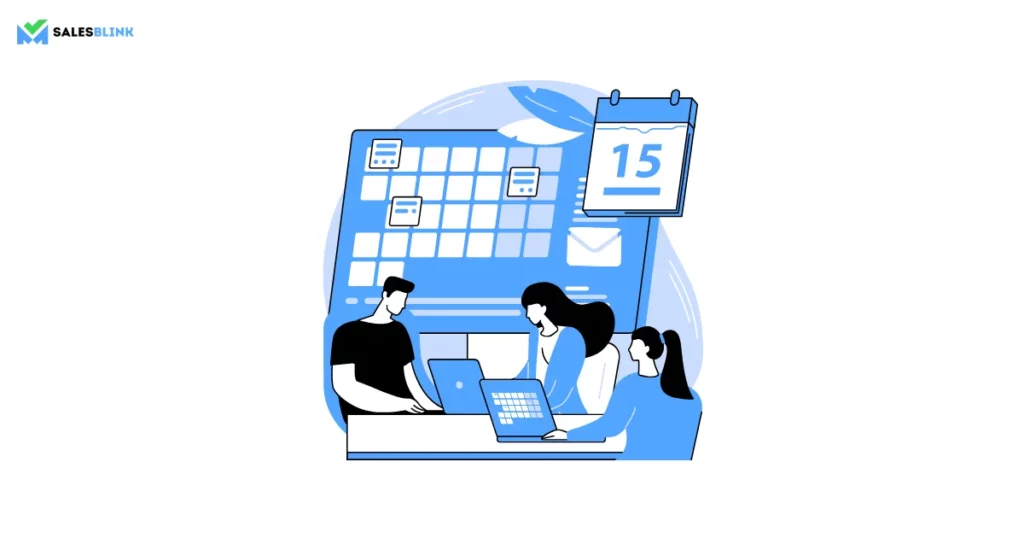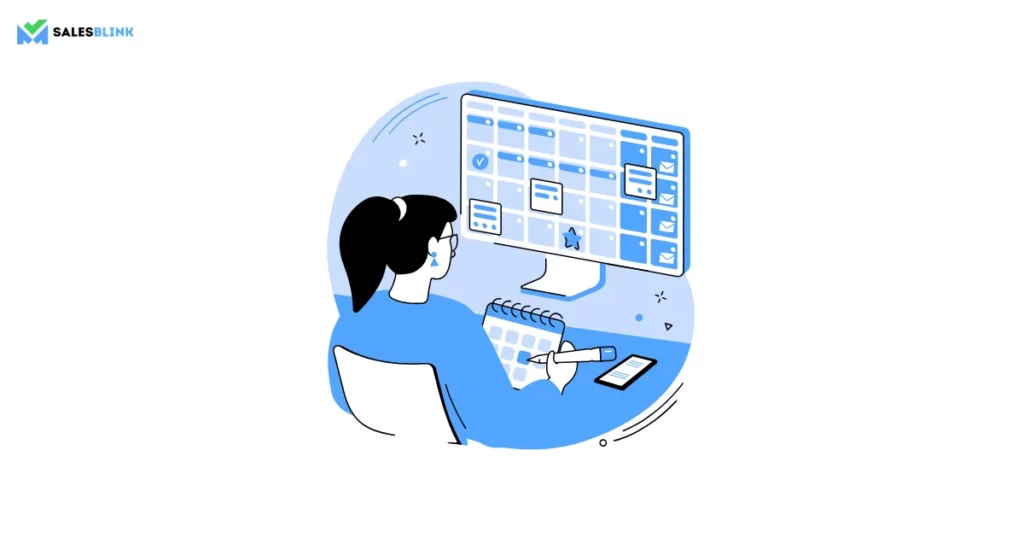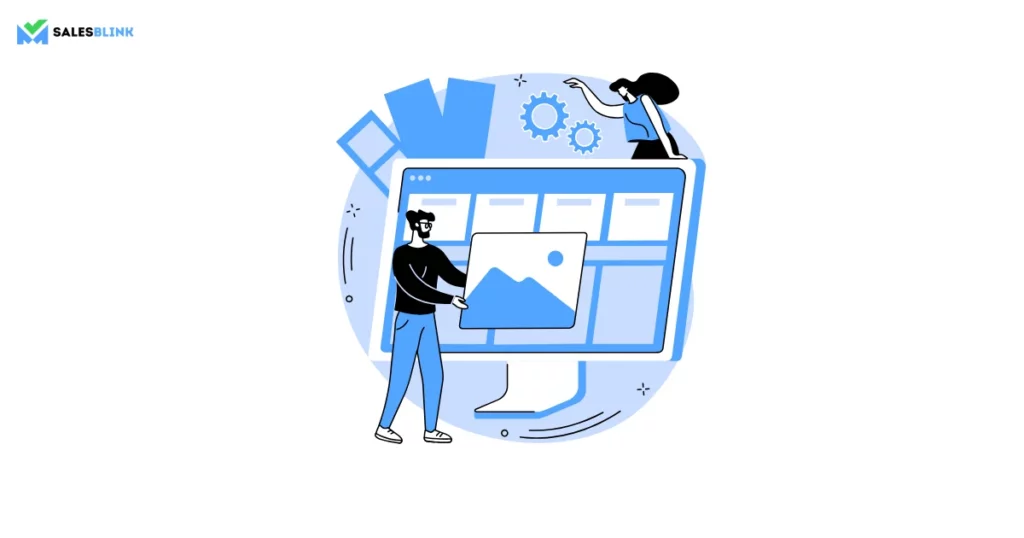How To Schedule A Meeting Via SalesBlink
Have you ever felt stuck waiting for email replies? It’s not surprising how emails get ignored, leading to delays and missed opportunities. This makes meetings a better alternative to expect more sales interaction and sealed deals!
A study discovered that face-to-face meetings were an incredible 3400% more likely to get positive responses than emails. This means in-person and virtual meet-ups can be advantageous in getting favorable client responses.
Meetings bring that personal touch that emails just can’t match. They let you connect in real-time, build trust, and collaborate effectively. However, many sales reps are unsure how to schedule a meeting with a client.
So, are you excited to make scheduling meetings a snap? With the right tool, you’ll set up meetings effortlessly and engage your clients like never before. Let’s dive into how to schedule a meeting on Salesblink!
How to Schedule a Meeting Via Email?

Starting with our Meeting Scheduler is easy, and here’s a quick look at how to schedule a teams meeting on Salesblink:
- Logging In: Simply sign in to your SalesBlink account. If you don’t have one yet, no problem! You create it in a few easy steps.
- Finding the Meeting Scheduler: Once you’re in, go to the meeting scheduler section. This is where you handle all your meeting requests.
- Creating a New Meeting Request: Click ‘Create New Meeting’ and fill in the required details – the meeting title, date, time, and duration.
- Add Participants: Enter the email addresses of your invitees. For added convenience, you can import contacts from an email or CRM.
- Draft the Email: Write a clear and concise email to accompany your meeting request. SalesBlink offers customizable templates to simplify this step.
- Set Reminders: Don’t forget to schedule reminders for your meeting. SalesBlink automatically sends reminders to ensure everyone is on the same page.
- Send the Request: Double-check all the details and hit send. SalesBlink tracks responses, so you’ll stay updated on attendees.
With these steps, you can effortlessly remove stress from the equation while enhancing professionalism. You can sit back and relax with all your tasks simplified and automated.
Benefits of Setting up Meetings Via Email

Planning meetings via email using SalesBlink comes with various perks that increase your efficiency and professionalism. Here’s why you’ll love using it:
- Get More Done, Faster: SalesBlink does the heavy lifting by automating scheduling. No more endless back-and-forth emails; focus on what truly matters during your meetings.
- Customized Invites: Use SalesBlink’s templates to customize your meeting invites. Make a lasting impression and show your clients you’re all about personalized service.
- Stay on Top of Things: Track RSVPs and responses effortlessly – who’s attending? Who’s not? SalesBlink keeps you organized, so you’re always one step ahead.
- Never Miss a Beat: Set up automatic reminders that nudge everyone about the upcoming meeting. No more last-minute no-shows; everyone shows up, and your meetings start on time.
- Smooth Management: SalesBlink syncs seamlessly with your email and CRM systems. No more juggling between platforms; everything you need is at your fingertips.
And that’s just the beginning! SalesBlink offers a comprehensive suite of email tools to cover all your needs. From email tracking and analytics to follow-up automation and personalized email campaigns, SalesBlink has everything you need to take your email productivity to the next level. You can check out our resources to find answers on:
- How To Schedule A Meeting On Google Meet On Salesblink
- How To Schedule A Meeting On Zoom On Salesblink
Tips While Scheduling a Meeting Via Email

Your meeting invites can easily hit the mark every time and get you the desired response. Check out these straightforward tips that can help you create effective invites:
Clear Subject Line
Your subject line is like the headline of your email. Make it catchy yet informative. For example, “Exploring Productive Teamwork Opportunities: Let’s Discuss” or “Action Required: Your Input Needed for [Project].” A clear subject line helps recipients understand the purpose of the meeting at a glance.
State Meeting Purpose
Once recipients open your email, they should immediately grasp why the meeting is essential. Use plain language to explain the meeting’s objectives and what outcomes you hope to achieve. Bullet points can be incredibly effective in breaking down complex information. You can also schedule a follow-up meeting to review progress and address any further questions or actions needed.
Polite Salutation
To set a friendly tone, start your email with a warm greeting. Address the recipient by name, such as “Hello [Name], I hope this email finds you well.” This personal touch makes the recipient feel valued and more likely to engage positively.
Send Reminders
Utilize SalesBlink’s handy reminder feature to gently nudge participants before the meeting. Reminders can be scheduled strategically to ensure everyone is aware and prepared. Consider adding a friendly note like, “Looking forward to seeing you at the meeting!” This way, you can also easily schedule recurring meetings.
Request Confirmation
End your email with a clear call-to-action asking for confirmation of attendance. Make it easy for recipients to respond with a simple “Yes” or “No.” You can add a friendly closing line such as, “Your presence will be greatly appreciated!”
These simple tips will make your meeting invites more effective and well-received. Also, pay attention to details and focus on clear communication. Use these strategies to make your invites clear, informative, and encouraging. They’ll inspire your recipients to join in.
Free Email Templates For Scheduling A Meeting

To kickstart your meeting invites, here are some free email templates you can use:
Template 1
Subject: Initial Meeting Request
Hi [Client’s Name],
I wanted to schedule a meeting to further discuss [specific topic]. Our team has been making exciting progress, and this discussion will benefit both of us.
Are you available on [date] at [time]? If this time doesn’t work for you, please let me know your availability, and I’ll do my best to accommodate.
Looking forward to your response.
Best regards,
[Your Name, Designation, and Company’s Name/Logo]
Template 2
Subject: Follow-Up Meeting
Hello [Client Name],
I’m reaching out to schedule a follow-up meeting regarding [specific topic] from our previous discussion. We’ve made significant progress and have new insights to share that I think will be valuable for our project.
How about we meet on [date] at [time]? If this doesn’t suit you, please suggest an alternative time that works for you.
I look forward to our continued collaboration.
Cheers,
[Your Name, Designation, and Company’s Name/Logo]
Template 3
Subject: Project Update Meeting
Dear [Client Name],
I hope this message finds you well. I’d like to schedule a meeting to provide a comprehensive update on [project name]. We’ve made significant progress and have some important milestones to discuss.
Would [date] at [time] work for you? If not, please let me know when you’re available, and we can find a suitable time.
Looking forward to your confirmation. Thank you for your continued partnership.Thanks,
[Your Name, Designation, and Company’s Name/Logo]
Template 4
Subject: Exploring Productive Teamwork Opportunities
Hi [Client Name],
I wanted to reach out and explore a potential collaboration opportunity with you regarding [specific topic]. Our team has been making exciting progress in this area, and I believe combining our expertise could lead to remarkable results.
Are you available on [date] at [time], or would another time be more convenient for you?
I’m looking forward to the opportunity to collaborate and work together effectively.
Best regards,
[Your Name, Designation, and Company’s Name/Logo]
Improvise these samples to match your specific needs and the tone of communication you wish to convey.
Simplify Sales Workflow and Boost Efficiency with SalesBlink
So, there you have it! You no longer need to worry about questions like “how to schedule meetings with multiple attendees,” “how to schedule follow-up meetings,” and so on. By following the steps mentioned above and using the provided templates, you’ll easily schedule meetings, giving you more time to focus on meaningful client connections. Moreover, SalesBlink makes scheduling meetings enjoyable, helping you build stronger client relationships. Personalizing meeting requests and reminders lets you cater to each client’s preferences, creating a lasting impression. It’s efficient, customizable, and keeps everyone on track. Combining SalesBlink with the tips for email-based meeting scheduling is a fantastic way to simplify your process. Give it a try, and watch your meetings become smoother than ever!







